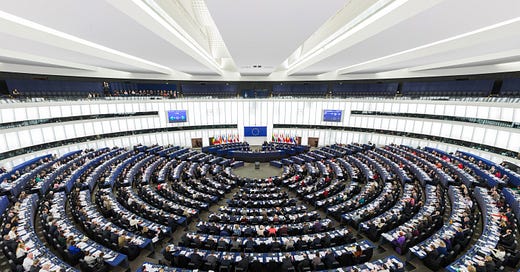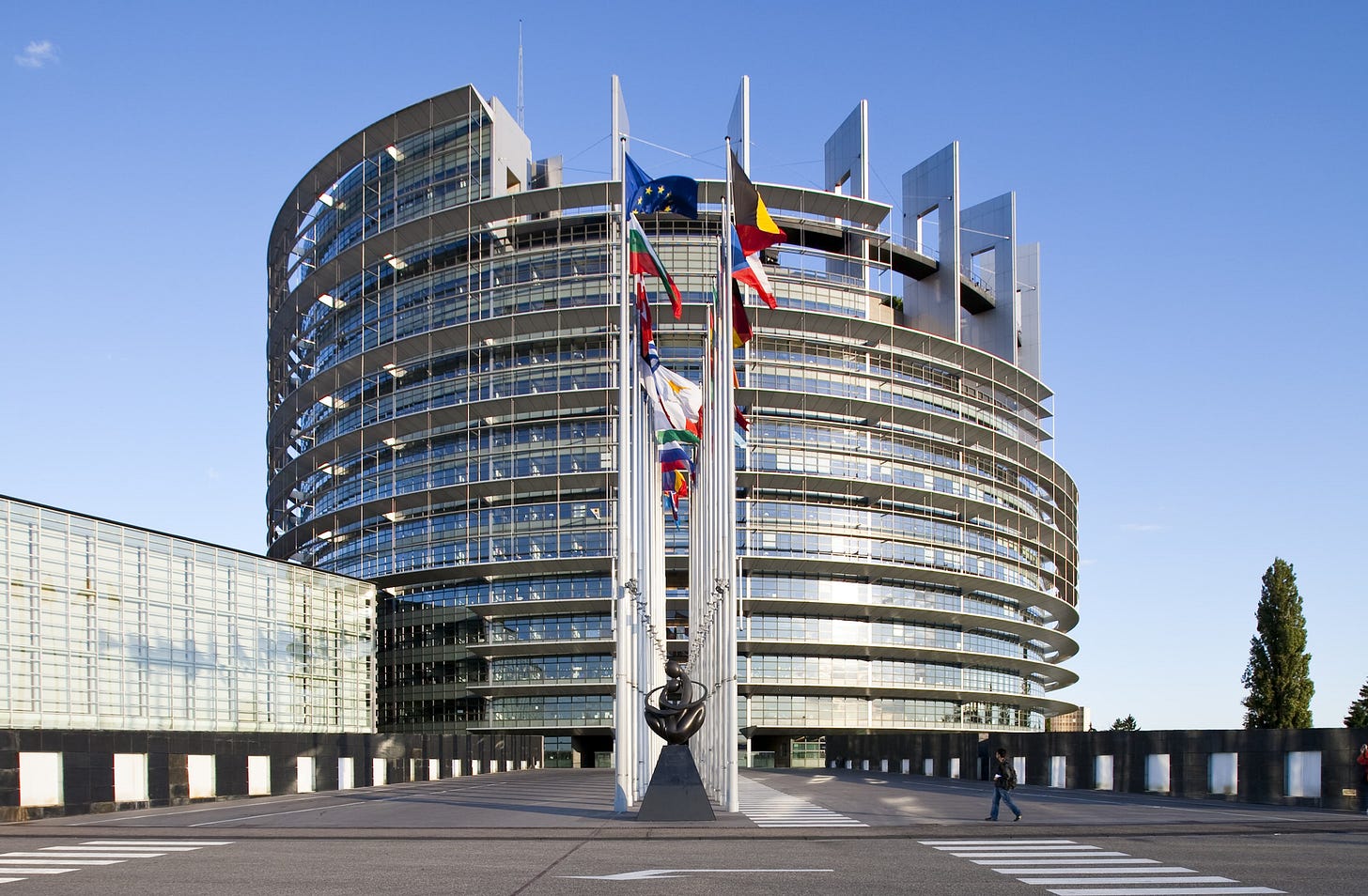European Union Parliamentary Elections: Key Takeaways
Surge of Right-Wing Parties Across Europe. History of EU and Eurozone. EU and NATO. Relations with India.
Europe Swings Sharply to the Right
The recent European Union parliamentary elections, involving over 373 million eligible voters from a population of more than 445 million across 27 member states, have brought about a notable shift towards right-wing parties in several European countries. This trend is evident in nations such as France, Italy, and Germany, where far-right parties have made significant gains, often at the expense of liberal and green parties. Although these right-wing factions did not perform as strongly as some had anticipated, their presence and influence in the EU parliament have undoubtedly increased. The European Parliament, composed of 720 seats, now reflects this growing right-wing influence, which is reshaping the political landscape of the EU.
EPP Emerges as the Largest Single Winner
Despite the rise of right-wing parties, the center-right European People's Party (EPP) emerged as the largest single winner of the elections. The EPP is set to retain control of the EU Parliament in collaboration with other pro-EU centrist parties. This outcome indicates that the political center has held firm, providing a counterbalance to the growing influence of the far-right. EU leaders have expressed relief and satisfaction that centrist forces remain dominant in the parliamentary landscape.
The Democratic Structure of the European Union
The European Union (EU) elections are a significant democratic exercise, with over 400 million eligible voters, making it the second largest election globally after India. The European Parliament, the EU's only directly elected institution, consists of 720 Members of the European Parliament (MEPs) elected every five years. The last elections, held from June 6-9, 2024, saw a voter turnout exceeding 50%, the highest since 1994. Seats in the Parliament are allocated based on population size, ranging from 6 for small countries like Malta to 96 for Germany, following the principle of degressive proportionality.
Elected MEPs join transnational political groups based on shared ideologies rather than nationality, with seven such groups currently in existence. The political group with the most seats attempts to form a majority coalition to elect the President of the European Commission and pass legislation. EU laws require approval from both the European Parliament and the Council of the EU, which represents national governments, underscoring the collaborative nature of the EU's legislative process.
Power Dynamics: European Parliament vs. Council of the EU
The Council of the European Union, also known as the Council of Ministers, is generally considered more powerful than the European Parliament, despite the Parliament's increasing powers over time. The Council, representing the executive governments of member states, has significant control over intergovernmental areas like foreign policy and sets the EU's overall political direction and priorities. While the Parliament cannot initiate legislation independently, it plays a crucial role as a co-legislator with the Council, particularly in approving the Commission President and Commissioners, and having an equal say on most legislation.
The Council, however, has the final say on the EU budget and often takes decisions by qualified majority voting, which can impose decisions on individual countries. Thus, while the European Parliament is a vital part of the legislative process, the Council of the EU holds greater overall power and influence, especially on critical issues such as budgets, foreign policy, and the EU's strategic direction.
Major Defeat for Macron's Party in France
In France, President Emmanuel Macron's party experienced a major setback, losing to Marine Le Pen's far-right National Rally. This defeat has prompted President Macron to call for snap national elections, highlighting the domestic political upheaval caused by the EU parliamentary results. The National Rally's success underscores the significant shift in French political sentiment towards the far-right.
Far-Right Gains in Germany
Germany also witnessed a significant rise in support for the far-right Alternative for Germany (AfD) party. The AfD surged to second place, surpassing Chancellor Olaf Scholz's Social Democrats, who suffered their worst electoral performance in over a century. This development marks a dramatic change in the German political landscape, reflecting growing discontent with mainstream parties.
Italy's Giorgia Meloni and the Brothers of Italy Party
In Italy, Prime Minister Giorgia Meloni, leader of the far-right Brothers of Italy party, saw her party make notable gains in the elections. Meloni is positioning herself as a significant player in European politics, further consolidating her influence both domestically and within the EU framework. The Brothers of Italy's success adds to the overall rightward shift in the EU parliament.
Limited Cohesion Among Far-Right Parties
While far-right parties have made substantial gains, their influence in the EU parliament may be curtailed by their lack of cohesion on key issues such as Ukraine and the economy. This internal division presents a challenge for these parties to exert a unified and effective force within the parliamentary structure. Mainstream parties are grappling with how best to respond to this fragmented yet rising far-right presence.
Decline in Support for Green and Liberal Parties
The elections also saw a decline in support for green and liberal parties across many countries. Analysts partly attribute this trend to a backlash against climate policies, particularly from groups like farmers and rural voters. The reduced backing for these parties indicates a shift in voter priorities and concerns, impacting the overall political dynamics within the EU parliament.
The Evolution and Impact of the European Union
The European Union (EU) is a political and economic union of 27 member states, established to promote peace, stability, and economic cooperation across Europe. Originating from the post-World War II era, the EU's predecessor, the European Economic Community (EEC), was created by the Treaty of Rome in 1957 to foster a common market among its founding members. Over the decades, the EEC evolved into the EU through significant milestones such as the Single European Act of 1986 and the Maastricht Treaty of 1993, which introduced the euro and expanded EU competencies.
The EU has grown through successive enlargements, most notably with the accession of 10 Central and Eastern European countries in 2004, and has navigated challenges like the financial crisis, the migration crisis, and Brexit. Today, the EU boasts a single market of over 440 million people, a robust GDP, and a complex institutional structure. Its policies span various domains, reflecting its role as a global power committed to maintaining peace, stability, and prosperity in Europe.
a.) Distinction Between the European Union and the Eurozone
The European Union (EU) and the Eurozone are distinct entities, with the EU being a political and economic union of 27 member states aimed at promoting peace, stability, and economic cooperation across Europe. In contrast, the Eurozone comprises 20 EU member states that have adopted the euro (€) as their official currency, forming a monetary union governed by the European Central Bank. Notably, seven EU countries—Bulgaria, Croatia, Czech Republic, Denmark, Hungary, Poland, Romania, and Sweden—do not use the euro, with Denmark having an opt-out arrangement.
Other non-euro countries are committed to adopting the euro once they meet the required criteria. Additionally, some non-EU countries like Andorra, Monaco, San Marino, and Vatican City use the euro through agreements with the EU, while Kosovo and Montenegro have adopted it unilaterally. Thus, while the euro is widely used within the EU, the Eurozone and EU remain separate, with some EU members retaining their national currencies.
b.) The EU-NATO Partnership: Distinct Roles, Shared Goals
The European Union (EU) and NATO are separate entities with distinct mandates, yet they share 21 member countries and maintain a close partnership. The EU is a political and economic union, while NATO is a military alliance focused on collective defense. Their cooperation spans shared values and interests in promoting peace, stability, and the rule of law in the Euro-Atlantic region. They leverage complementary capabilities—NATO's military strength and the EU's political, economic, and diplomatic tools—to address common challenges. This partnership is reinforced by joint declarations, operational cooperation in regions like the Balkans and the Mediterranean, and regular institutional dialogue. Despite challenges such as the Cyprus-Turkey dispute and concerns over potential duplication of efforts, their collaboration remains crucial for addressing complex security issues and promoting stability in Europe and beyond.
India and EU Trade Relations
India and the European Union (EU) share a robust trade relationship, with the EU being India's third largest trading partner, accounting for €88 billion in trade in goods in 2021, while India ranks as the EU's tenth largest trading partner. In June 2022, the two parties relaunched negotiations for a comprehensive Free Trade Agreement (FTA), aiming to conclude by 2024 after previous talks stalled in 2013. This FTA is poised to significantly boost trade and investment flows, given the EU's position as India's largest source of foreign investment. Key issues in the negotiations include tariffs, market access, generic drugs, agriculture, visas for Indian professionals, and India's status as a data secure country. Notably, in March 2024, India signed a $100 billion free trade deal with the European Free Trade Association (EFTA), lifting most tariffs on industrial goods, underscoring the potential for enhanced economic collaboration.
Political Engagement Between India and the EU
India and the EU have maintained a strategic partnership since 2004, underscored by annual summits, with the latest held in 2020. This partnership encompasses cooperation in areas such as security, counterterrorism, maritime issues, climate change, and the promotion of a rules-based international order. However, political engagement has faced challenges, notably India's neutral stance on Russia's invasion of Ukraine in 2022, which frustrated many in Europe. Despite this, shared concerns over China have provided a foundation for renewed dialogue.
Navigating the Evolving EU-India Partnership
The 2024 European Parliament elections, which saw significant gains by far-right parties, underscore a fragmented political landscape in Europe that India must navigate carefully. This fragmentation is further compounded by domestic political shifts, such as French President Emmanuel Macron calling snap elections following his party's defeat to the far-right. These changes have direct implications for EU-India engagement. While France is set to face elections in 2024, India has already re-elected Prime Minister Narendra Modi for a third successive five-year term after a protracted and high-decibel election. The engagement of both regions on global issues will be crucial in shaping the future of this strategic partnership. As Europe and India maneuver through their respective political landscapes, their cooperation and dialogue on shared concerns will be pivotal in maintaining and enhancing their relationship amidst evolving geopolitical challenges.
The EU's Global Economic and Regulatory Influence
The European Union (EU) stands as a major economic bloc that even the United States cannot ignore. Known for its excellent regulatory practices, the EU places consumer protection, privacy, and human rights at the forefront of its policies. Unlike a copycat of the US, the EU upholds rigorous standards for health and safety, making it a unique and formidable player on the global stage. However, the EU faces several internal challenges, such as immigration issues, particularly from Islamic nations, which have become divisive. Additionally, an ageing population poses demographic challenges that may require the EU to reinvent itself to maintain its ascendancy, especially in the post-Brexit era. The political and economic landscape of Europe remains complex and dynamic, requiring continuous adaptation to preserve its influential position globally.
If you believe this article would interest someone you know, please feel free to share it anonymously (for us), using any platform that you prefer.






